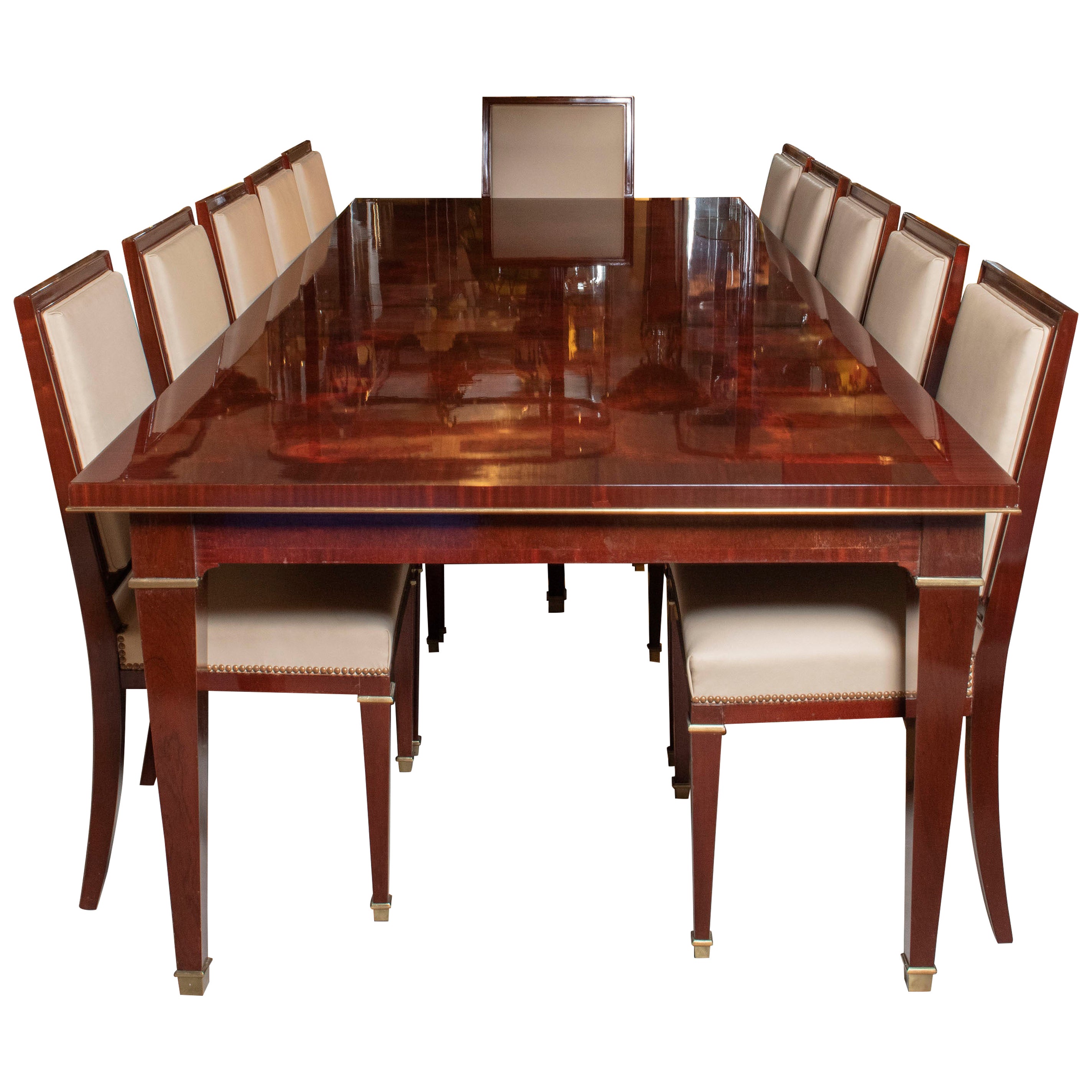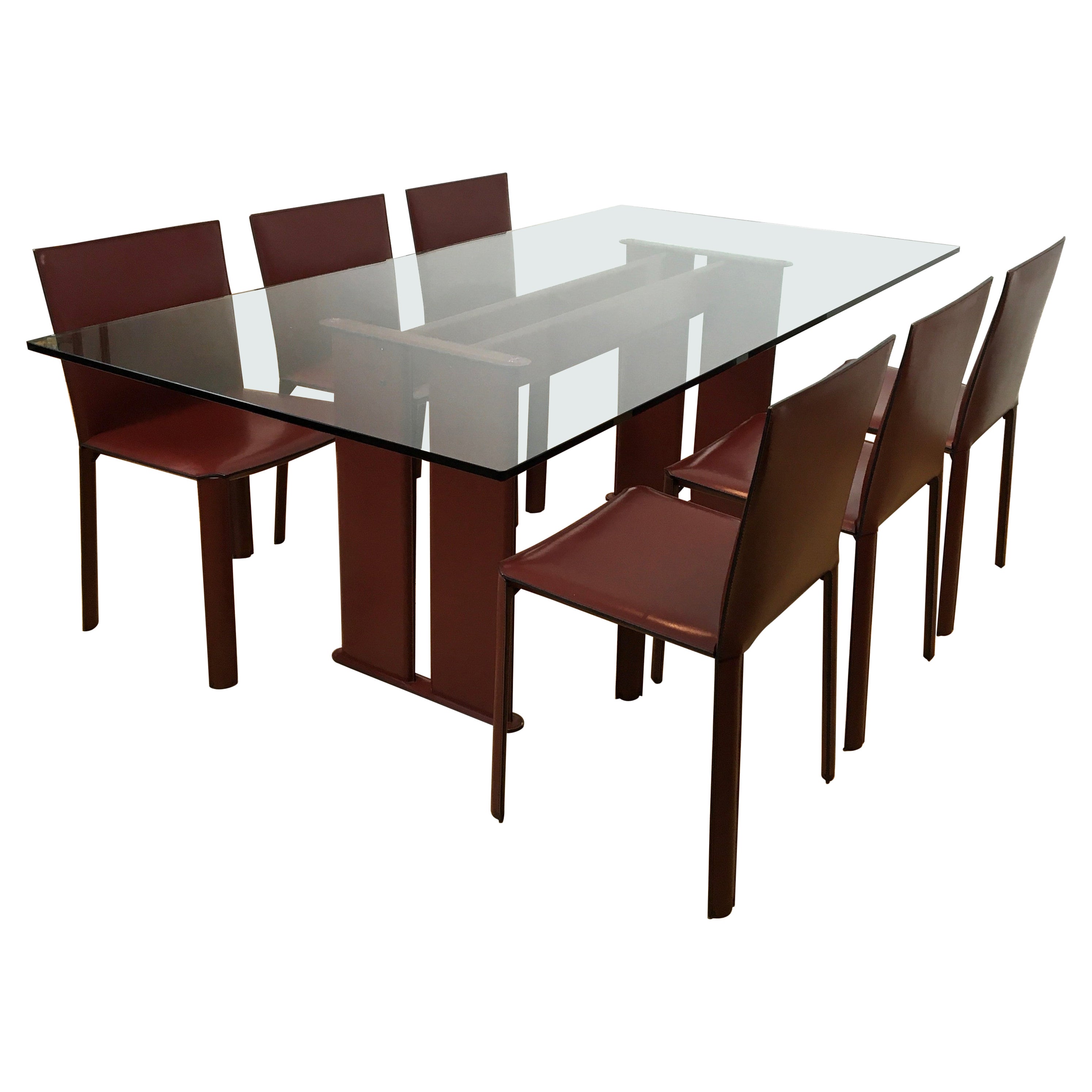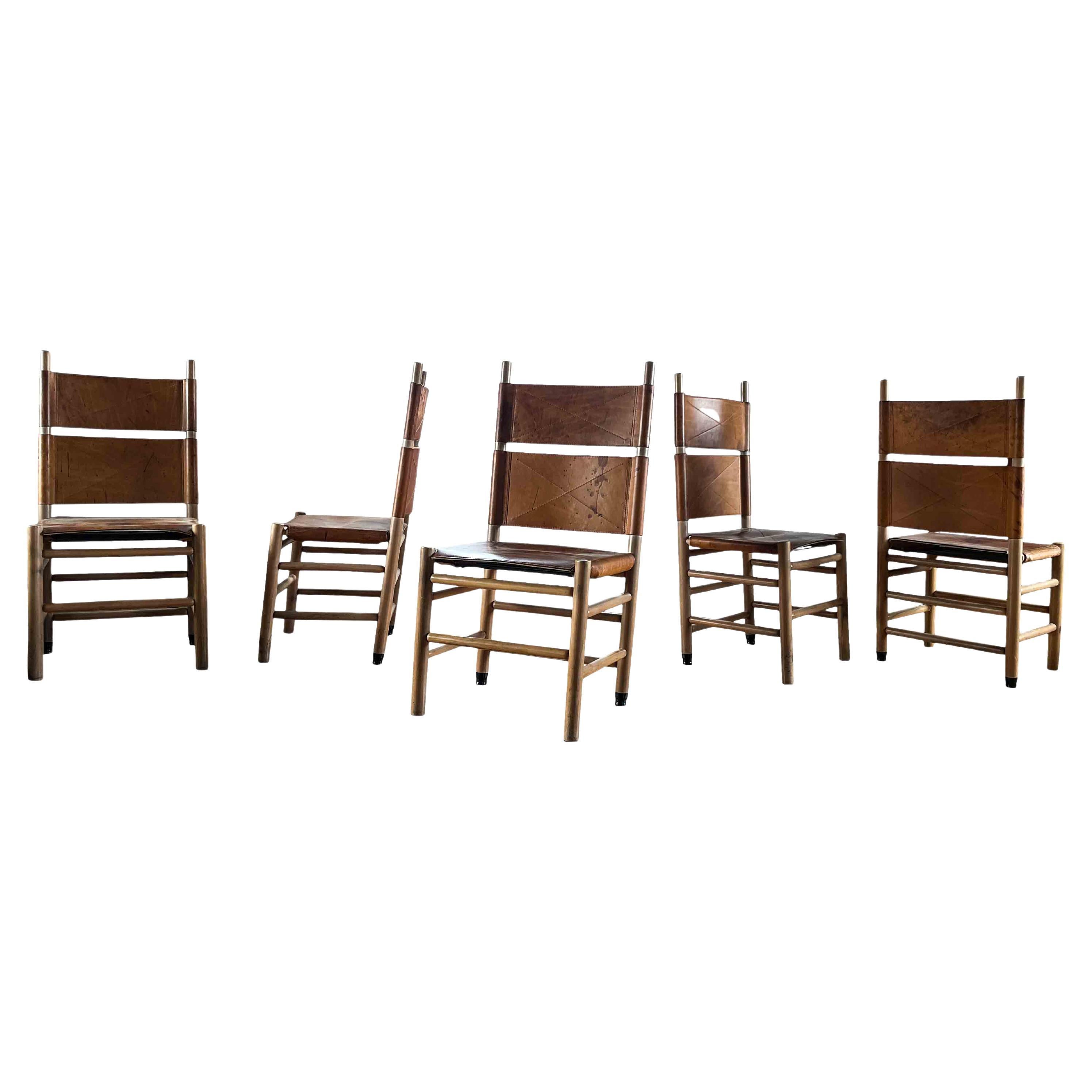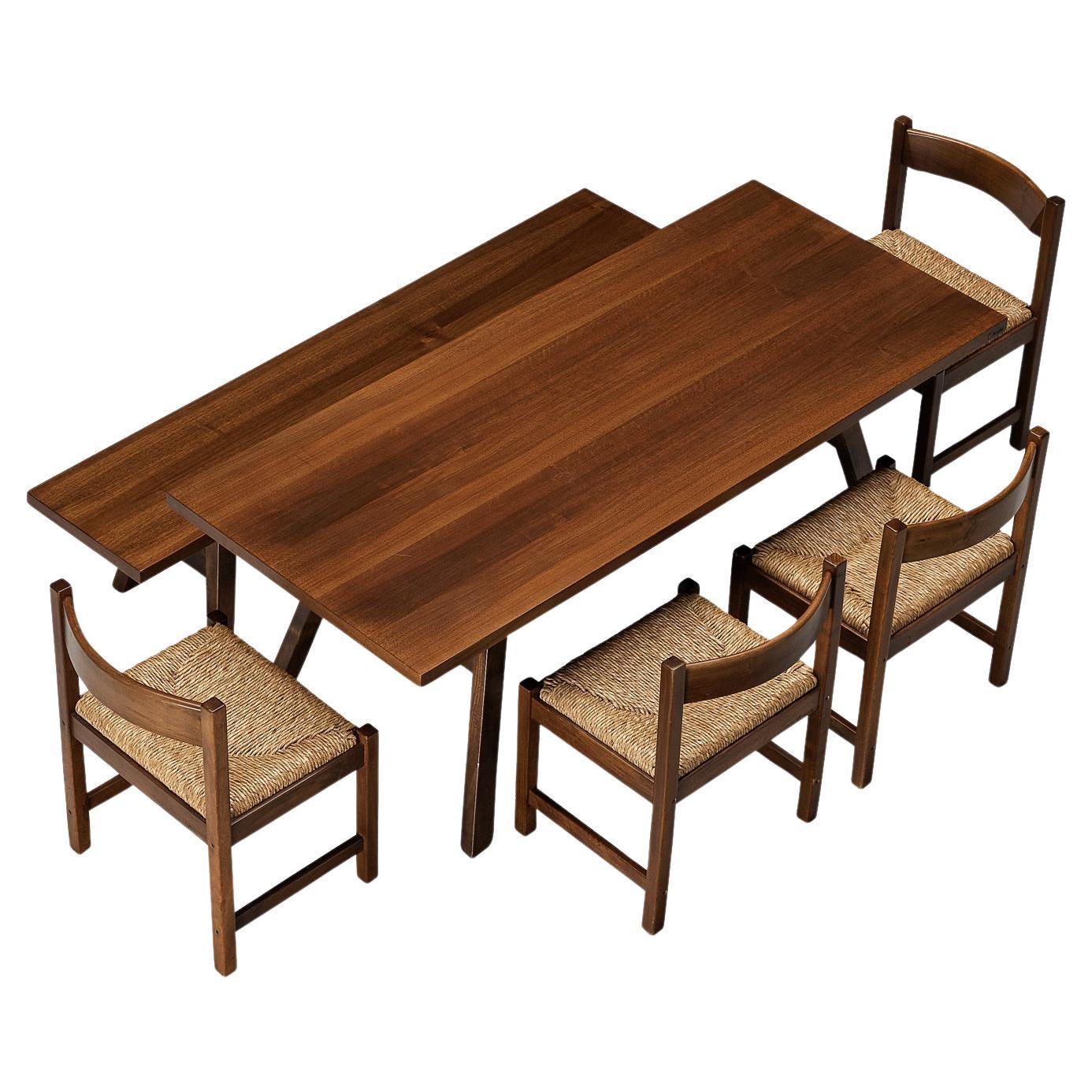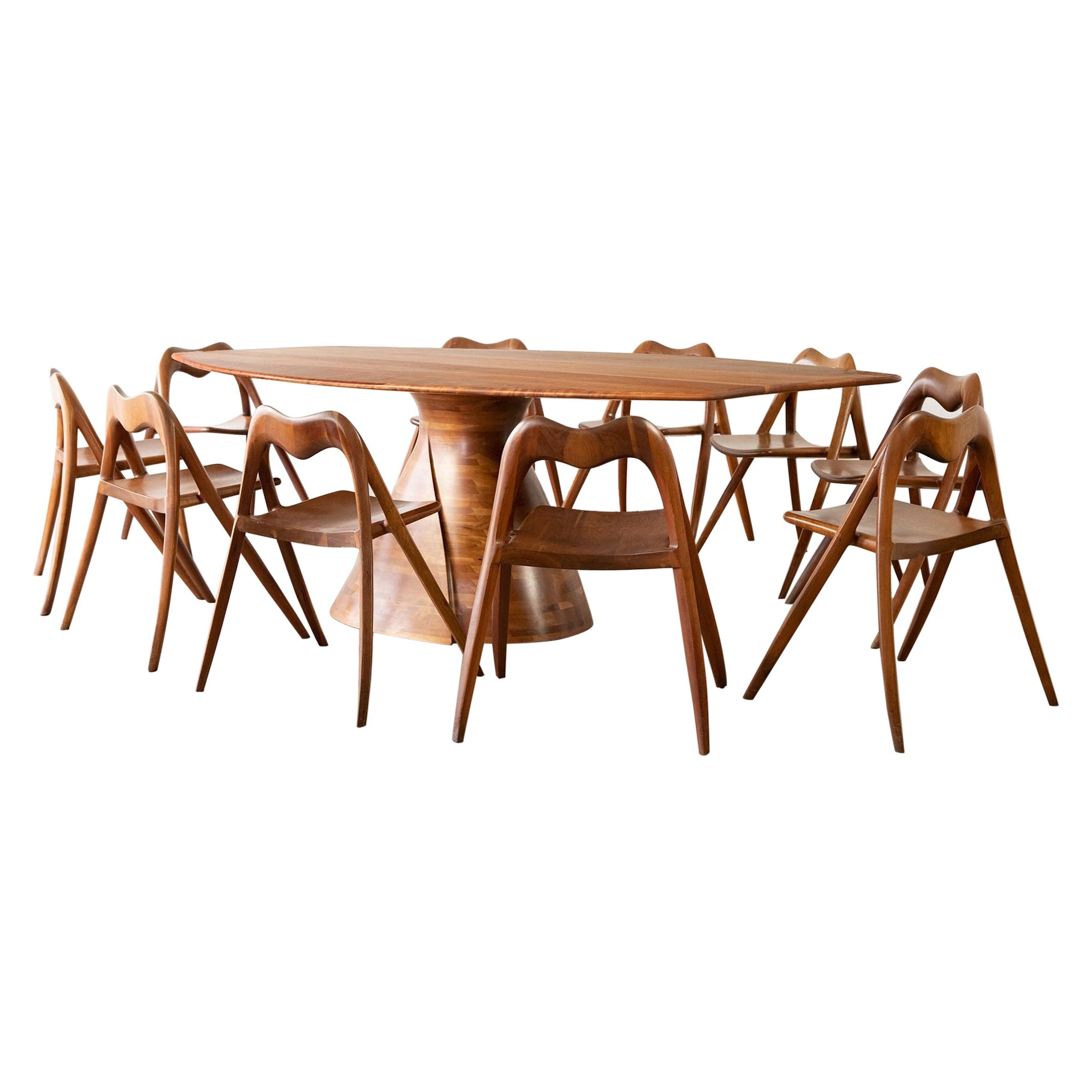Items Similar to Dining Set for 3 People, 1970, Set of 4
Want more images or videos?
Request additional images or videos from the seller
1 of 13
Dining Set for 3 People, 1970, Set of 4
About the Item
A solution for upper middle-class furnishing, with effect and impact. Visible quality and elegance of design. The set for three persons consists of: a table H 48 cm x diameter 119 cm and three chairs H 87 cm x 45 cm x depth 55 cm, seat H 44 cm.
- Dimensions:Height: 30.71 in (78 cm)Diameter: 46.86 in (119 cm)
- Sold As:Set of 4
- Materials and Techniques:
- Place of Origin:
- Period:
- Date of Manufacture:1970-1979
- Condition:The vintage item has no defects but may show slight traces of wear due to age and use. Fabric to be cleaned or replaced.
- Seller Location:Montelabbate, IT
- Reference Number:
About the Seller
5.0
Vetted Seller
These experienced sellers undergo a comprehensive evaluation by our team of in-house experts.
1stDibs seller since 2022
40 sales on 1stDibs
Typical response time: 21 hours
- ShippingRetrieving quote...Ships From: Montelabbate, Italy
- Return PolicyA return for this item may be initiated within 14 days of delivery.
More From This SellerView All
- Dining Table Set by Pierre Cardin for Roche Bobois, 1970s, Set of 6By Roche BoboisLocated in Montelabbate, PUDining room set by Pierre Cardin for Roche Bobois, 1970s. Black lacquered wood set consisting of four chairs, a table and a sideboard. The table has an extendable glass top (extensio...Category
Vintage 1970s Italian Modern Dining Room Sets
MaterialsGlass, Wood, Lacquer
- Rosewood & Steel Dining Table, 1970sBy Saporiti, Gianni OffrediLocated in Montelabbate, PURosewood & Steel Dining Table, 1970s Packaging with bubble wrap and cardboard boxes is included. If the wooden packaging is needed (crates or boxes) for US and International Shippin...Category
Vintage 1970s Italian Dining Room Tables
MaterialsSteel
- Glass and Steel Dining Table, 1970sBy Marzio CecchiLocated in Montelabbate, PURare squared dining table attributed to the Italian designer Marzio Cecchi and made in the 1960s. Glass top with border on irregular large chromed steel legs, Italy, 60s. Dimensions:...Category
Vintage 1970s Italian Dining Room Tables
MaterialsSteel
- Extendable Chestnut Fratino Dining Table, 1970sLocated in Montelabbate, PUExtendable Chestnut Fratino dining table, 1970s Extensions not available ! Packaging with bubble wrap and cardboard boxes is included. If the wooden packaging is needed (fumigated ...Category
Vintage 1970s Dining Room Tables
MaterialsChestnut
- Lacquered Wood & Painted Metal Dining Table, 1970sLocated in Montelabbate, PUTable from the 1970s. Ivory lacquered solid wood legs, black painted iron sheet connecting element, crystal top with cut edges. It shows light wear due to age and use. This piece was...Category
Vintage 1970s Post-Modern Dining Room Tables
MaterialsMetal
- Art Deco Rosewood & Marble Dining Room Set, 1930s, Set of 10Located in Montelabbate, PUHigh cabinetry dining room set, consisting of: 2 sideboards, a mirror, table and 6 chairs. The sideboards are moved, with finely carved feet in an elong...Category
Vintage 1930s Italian Art Deco Buffets
MaterialsMarble, Bronze
You May Also Like
- Wood, Leather and Bronze Dining Room Set for 12 People, Argentina, 1938Located in Buenos Aires, Buenos AiresMahogany wood, leather and bronze dining room set for 12 people. Argentina, 1938. Designed by the architect Alejandro Bustillo (1889-1982) for ...Category
Vintage 1930s Argentine Art Deco Dining Room Sets
MaterialsBronze
- De Couro of Brazil Red Leather Dining Room Set for 6, 1980sBy deCouro of BrazilLocated in Antwerp, BEDe Couro of Brasil red leather dining room set. All in red nubuck leather; 6 dining room chairs and also the base of the dining room table. On top a very thick rounded glass top. ...Category
Vintage 1980s Modern Dining Room Sets
MaterialsLeather
- Nerone & Patuzzi Dining Table for Gruppo NP2, 1970sBy Nerone and Patuzzi, Gruppo NP2Located in Lonigo, VenetoNerone & Patuzzi dining table for Gruppo NP2, glass, iron and wood, Italy, 1970s. Designed by the Italian duo Nerone and Patuzzi, this dining table is a work of art. The base consis...Category
Vintage 1970s Italian Mid-Century Modern Dining Room Tables
MaterialsIron
- Carlo Scarpa Cognac Leather “Kentucky” Dining Chair for Bernini, 1977, Set of 5By Carlo Scarpa, BerniniLocated in Vicenza, ITSet of 5 mod. 783 “Kentucky” dining chairs, designed by Carlo Scarpa for the Italian manufacturer Bernini in 1977. Structure made from oak and walnut timber. Seats and backrest made from cognac leather. Excellent vintage condition. Carlo Scarpa designed this chair for the “Scuderia” series., the last project he made for Bernini. The architect took inspiration from the “shaker” movement. He designed the chair slightly inclined at the front. This feature allows you to swing backward (until you lean on a wall) and remain in balance. Born in Venice on June 2nd, 1906, Carlo Scarpa began working at a very early age. A year after he had first qualified as an architect in 1926, he began working for the Murano glassmakers Cappellin & Co. in a consultative capacity. From 1927, Carlo Scarpa began to experiment with the Murano glass, and this research not only gave him excellent results here but would also inform his progress for many years to come. Between 1935 and 1937, as he entered his thirties, Carlo Scarpa accepted his first important commission, the renovation of Venice’s Cà Foscari. He adapted the spaces of this stately University building that stands on the Grand Canal banks, creating rooms for the Dean’s offices and a new hall for academic ceremonies; Mario Sironi and Mario De Luigi were charged with doing the restoration work on the frescos. After 1945, Carlo Scarpa found himself constantly busy with new commissions, including various furnishings and designs for the renovation of Venice’s Hotel Bauer and designing a tall building in Padua and a residential area in Feltre, all worth mentioning. One of his key works, despite its relatively modest diminished proportions, was the [bookshop known as the] Padiglione del Libro, which stands in Venice’s Giardini di Castello and clearly shows Scarpa’s passion for the works of Frank Lloyd Wright. In the years which were to follow, after he had met the American architect, Scarpa repeated similar experiments on other occasions, as can be seen, in particular, in the sketches he drew up in 1953 for villa Zoppas in Conegliano, which show some of his most promising work. However, this work unfortunately never came to fruition. Carlo Scarpa later created three museum layouts to prove pivotal in terms of how twentieth-century museums were set up from then on. Between 1955 and 1957, he completed extension work on Treviso’s Gipsoteca Canoviana [the museum that houses Canova’s sculptures] in Possagno, taking a similar experimental approach to the one he used for the Venezuelan Pavilion at [Venice’s] Giardini di Castello which he was building at the same time (1954-56). In Possagno Carlo Scarpa was to create one of his most significant ever works, which inevitably bears comparison with two other museum layouts that he was working on over the same period, those of: – Galleria Nazionale di Sicilia, housed in the Palazzo Abatellis in Palermo (1953-55) – Castelvecchio in Verona (1957- 1974), all of which were highly acclaimed, adding to his growing fame. Two other buildings, which are beautifully arranged in spatial terms, can be added to this long list of key works that were started and, in some cases, even completed during the nineteen fifties. After winning the Olivetti award for architecture in 1956, Scarpa began work in Venice’s Piazza San Marco on an area destined to house products made by the Industrial manufacturers Ivrea. Over the same period (1959-1963), he also worked on the renovation and restoration of the gardens and ground floor of the Fondazione Querini Stampalia in Venice, which many consider one of his greatest works. While he busied himself working on-site at the Fondazione Querini Stampalia, Carlo Scarpa also began work building a villa in Udine for the Veritti family. To shed some light on the extent to which his work evolved over the years, it may perhaps be useful to compare this work with that of his very last building, villa Ottolenghi Bardolino, which was near to completion at the time of his sudden death in 1978. Upon completion of villa Veritti over the next ten years, without ever letting up on his work on renovation and layouts, Scarpa accepted some highly challenging commissions, working on the Carlo Felice Theatre in Genoa and another theatre in Vicenza. Towards the end of this decade, in 1969, Rina Brion commissioned Carlo Scarpa to build the Brion Mausoleum in San Vito d’Altivole (Treviso), a piece he continued to work on right up until the moment of his death. Nevertheless, even though he was totally absorbed by work on this mausoleum, there are plenty of other episodes which can offer some insight into the final years of his career. As work on the San Vito d’Altivole Mausoleum began to lessen from 1973, Carlo Scarpa started building the new headquarters for the Banca Popolare di Verona. He drew up plans that were surprisingly different from the work he was carrying out at the same time on the villa Ottolenghi. However, the plans Carlo Scarpa drew up, at different times, for a monument in Brescia’s Piazza della Loggia commemorating victims of the terrorist attack on May 28th, 1974, make a sharp contrast to the work he carried out in Verona, almost as if there is a certain hesitation after so many mannered excesses. The same Pietas that informs his designs for the Piazza Della Loggia can also be seen in the presence of the water that flows through the Brion Mausoleum, almost as if to give a concrete manifestation of pity in this twentieth-century work of art. Carlo Scarpa has put together a highly sophisticated collection of structures, occupying the mausoleum’s L-shaped space stretching across both sides of the old San Vito d’Altivole cemetery. A myriad of different forms and an equally large number of different pieces, all of which are separate and yet inextricably linked to form a chain that seems to offer no promise of continuity, rising up out of these are those whose only justification for being there is to bear the warning “si vis vitam, para mortem,” [if you wish to experience life prepare for death] as if to tell a tale that suggests the circle of time, joining together the commemoration of the dead with a celebration of life. At the entrance of the Brion Mausoleum stand the “propylaea” followed by a cloister which ends by a small chapel, with an arcosolium bearing the family sarcophagi, the main pavilion, held in place on broken cast iron supports, stands over a mirror-shaped stretch of water and occupies one end of the family’s burial space. The musical sound of the walkways teamed with the luminosity of these harmoniously blended spaces shows how, in keeping with his strong sense of vision, Carlo Scarpa could make the most of all of his many skills to come up with this truly magnificent space. As well as a great commitment to architectural work, with the many projects which we have already seen punctuating his career, Carlo Scarpa also made many equally important forays into the world of applied arts. Between 1926 and 1931, he worked for the Murano glassmakers Cappellin, later taking what he had learned with him when he went to work for the glassmakers Venini from 1933 until the 1950s. The story of how he came to work on furniture design is different, however, and began with the furniture he designed to replace lost furnishings during his renovation of Cà Foscari. The later mass-produced furniture started differently, given that many pieces were originally one-off designs “made to measure.” Industrial manufacturing using these designs as prototypes came into being thanks to the continuity afforded him by Dino Gavina, who, as well as this, also invited Carlo Scarpa to become president of the company Gavina SpA, later to become SIMON, a company Gavina founded eight years on, in partnership with Maria Simoncini (whose own name accounts for the choice of company name). Carlo Scarpa and Gavina forged a strong bond in 1968 as they began to put various models of his into production for Simon, such as the “Doge” table, which also formed the basis for the “Sarpi” and “Florian” tables. In the early seventies, other tables that followed included “Valmarana,” “Quatour,” and “Orseolo.” While in 1974, they added couch and armchair “Cornaro” to the collection and the “Toledo” bed...Category
Vintage 1970s Italian Mid-Century Modern Dining Room Tables
MaterialsWalnut, Leather, Plastic
- Giovanni Michelucci for Poltronova ´Torbecchia´ Dining Room Set in WalnutBy Poltronova, Giovanni MichelucciLocated in Waalwijk, NLGiovanni Michelucci for Poltronova, ´Torbecchia´ dining room set; table, bench and four chairs, walnut, cane, Italy, circa 1964. This dining room set contains one table, a bench and...Category
Vintage 1960s Italian Mid-Century Modern Dining Room Sets
MaterialsCane, Walnut
- Claude Terrell Magnum Opus Dining Set 1970s Organic Studio Crafted ModernismLocated in Dallas, TXClaude Terrell custom dining table for a private New York residence includes the 10 original matching chairs. 1978. Hand-crafted solid cherry wood dinin...Category
Mid-20th Century American Organic Modern Dining Room Sets
MaterialsCherry
Recently Viewed
View AllMore Ways To Browse
Vintage 4 Seater Dining Table
4 Seat Dining Table Set
Cherry Dining Set
Cherry Dining Room Chair Set
Vintage Cherry Dining Room Set
4 Person Dining
Vintage Glass Table With 4 Chairs
4 Person Table
Italian Dining Chairs Set Of 3
4 Person Dining Table
4 Person Dining Room Table
4 Person Dining Set
Dining Room Table And 10 Chairs
Saarinen For Knoll Tulip Table
Round Dining Table Vintage Wood
Knoll Marble Table Top
Metal Base Oval Table
Retro Round Teak Dining Table
